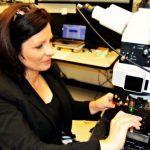
Laurene Tetard and her research team have developed a new method for identifying materials’ unique chemical vibrations and mapping their chemical properties at a much higher spatial resolution than ever before.
The new approach is able to identify materials based on differences in the vibration produced when they’re subjected to different wavelengths of light.
Results from the study will help reveal better methods for producing the most biofuel from cottonwood, the material examined using the new identification method, and help determine whether other plants are good candidates for biofuel production.
Other potential uses of the new identification method include studying the effect of new treatments on citrus trees to save them from bacterial diseases rapidly decimating the citrus industry and studying the fundamental photonically-induced processes in complex systems such as in solar cell materials or opto-electronic devices.
The research team included Laurene Tetard; Ali Passian, R.H. Farahi and Brian Davison, all of Oak Ridge National Laboratory; and Thomas Thundat of the University of Alberta.
For more information about the research, head over to the original news posting on UCFToday.
You can read the research paper in the current issue of Nature Nanotechnology.